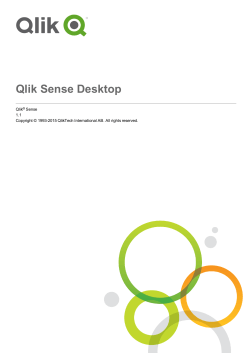
Qlik Sense Multi-node Setup Guide (DFAFT)
Qlik Sense Multi-node Setup Guide (DFAFT) Introduction This article explains how to add a rim node to an existing central node to build a Qlik Sense 1.0.2 multi-nodes environment. (This is NOT an official document distributed by QlikTech.) Prerequisite Install the first Qlik Sense Server node as a central node. (standalone server) Install the second Qlik Sense Server node as a rim node. You can do it by unchecking “Central Node” option while installation. You can also choose services to install (Engine, Proxy, Repository and Scheduler) by selecting “CUSTOM INSTALL”. The following ports need to be opened in Windows Firewall: Central Node Port Description 443 Default Qlik Sense Proxy Service (QPS) API service port. This port uses https for communication. 4144 Default port for the internal authentication module in the Qlik Sense Proxy Service (QPS) when using NTLM in Microsoft Windows. 4241 Communication port within multi-node sites for QRS-to-QRS synchronization. 4242 Qlik Sense Repository Service (QRS) API service port. Also used as synchronization service port within multi-node sites for QRS-to-QRS synchronization. 4243 Qlik Sense Proxy Service (QPS) REST server. 5050 Qlik Sense Scheduler Service (QSS) master REST engine. 5051 Qlik Sense Scheduler Service (QSS) slave REST engine. Rim Node Port Description 443 Default Qlik Sense Proxy Service (QPS) API service port. This port uses https for communication. 4144 Default port for the internal authentication module in the Qlik Sense Proxy Service 1 (QPS) when using NTLM in Microsoft Windows. 4241 Communication port within multi-node sites for QRS-to-QRS synchronization. 4242 Qlik Sense Repository Service (QRS) API service port. Also used as synchronization service port within multi-node sites for QRS-to-QRS synchronization. 4243 Qlik Sense Proxy Service (QPS) REST server. 4444 Security distribution port, only used within multi-node sites by non-master Qlik Sense Repository Services (QRSs) to receive a certificate from the master QRS. 5051 Qlik Sense Scheduler Service (QSS) slave REST engine. Setup Steps 1. Click [Configure System] > [Nodes] on the QMC. 2. Click [Create new]. 2 3. Fill in the boxes and click [Apply]. 4. The central node starts to communicate with the rim node. 3 5. After the communication with the rim node was established, a dialogue box which asks for authorization of the certificate is displayed. 6. Connect to the rim node on RDP and open a browser. Then, access to the following URL and submit the password displayed on the dialogue box in the previous step: http://localhost:4570/certificateSetup 4 7. “The service was successfully unlocked.” 8. You go back to QMC and make sure that the status of the added rim node is turned to “running”. 9. You need to perform the following configuration on the proxy of the added rim node. (This is necessary only when you installed proxy service on the rim node.) Adding a node to “Load balancing nodes”. Adding entries to “Web socket origin white list”. 5 6
© Copyright 2025














